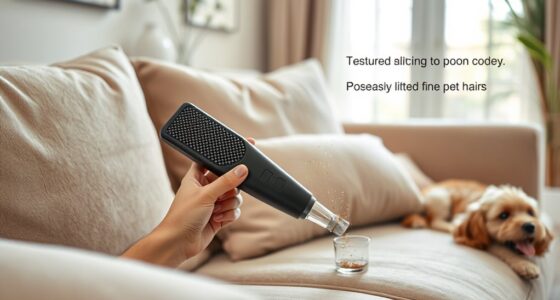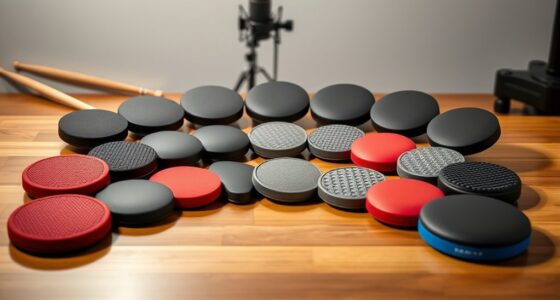If you’re looking for the 15 best wireless guitar systems of 2025, I’ve got you covered. I focus on options with strong signals, minimal latency, and long battery life that suit live performances and studio work. From top brands like LEKATO, JOYO, and Xvive, you’ll find systems supporting multiple channels, easy setup, and reliable range. Keep exploring to discover more about these systems and find the perfect match for your playing style.
Key Takeaways
- Prioritize systems with 5.8GHz frequencies for stronger anti-interference and stable connections in crowded venues.
- Consider models with 24bit/48KHz audio and low latency (around 5ms) for professional sound quality.
- Look for long battery life (over 5 hours) and fast recharge options for extended performances.
- Choose plug-and-play, versatile units compatible with multiple instruments and featuring auto-pairing.
- Opt for lightweight, portable designs with additional features like rotatable plugs and multiple channels for flexibility.
LEKATO Wireless Guitar System (Black)

If you’re a guitarist who needs reliable, high-quality wireless performance, the LEKATO Wireless Guitar System (Black) is an excellent choice. It operates on a 5.8GHz frequency, offering stronger anti-interference than 2.4GHz systems. The plug-and-play design makes setup quick—just hold the signal key to match transmitter and receiver. With 24-bit 48KHz audio and less than 6ms latency, it delivers clear, lag-free sound. The effective range is about 100 feet, perfect for stage performances. Compatible with most electric and acoustic guitars, it features a rechargeable battery lasting up to five hours, ensuring uninterrupted playing during gigs.
Best For: guitarists and musicians seeking a reliable, high-quality wireless system for live performances and recording sessions.
Pros:
- Strong anti-interference with 5.8GHz frequency for stable performance
- Plug-and-play setup for quick and easy connectivity
- High-fidelity 24-bit 48KHz audio with minimal latency
Cons:
- Limited to approximately 100 feet transmission range
- Rechargeable battery lasts about five hours, which may require frequent recharging during extended gigs
- Compatibility may vary with certain instrument outputs or pickups
JOYO Wireless Guitar System with Charging Box (JW-06)
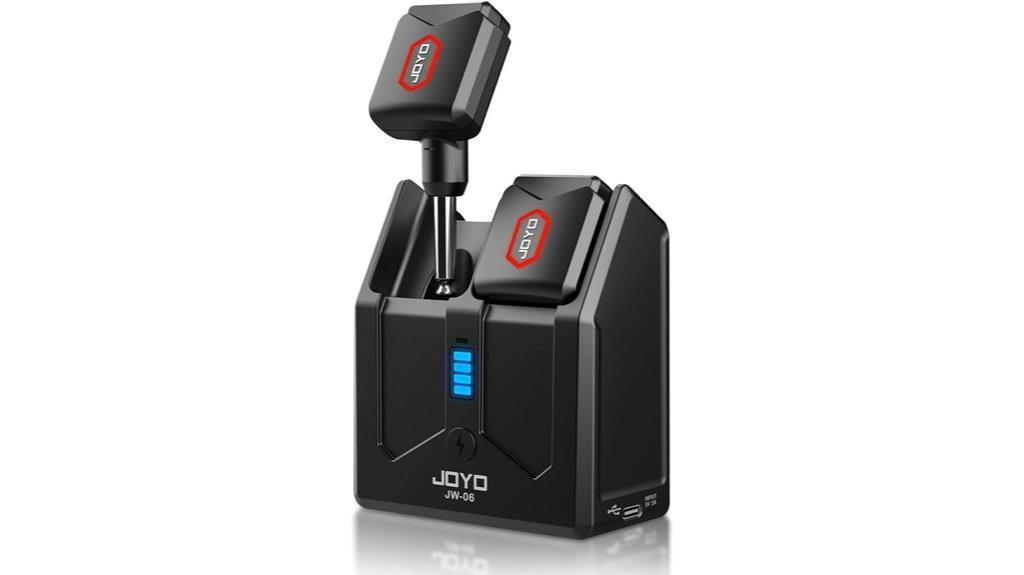
The JOYO Wireless Guitar System with Charging Box (JW-06) stands out as an ideal choice for musicians who need reliable, long-lasting wireless connectivity during live performances or practice sessions. Operating on 5.8GHz, it delivers clear, stable sound with minimal noise and latency, even in crowded venues. The rechargeable charging box provides up to 6 hours of use and can power the system twice, ensuring continuous performance. Its versatile connector fits most electric guitars, basses, and effects pedals. With four signal channels and easy pairing, the JW-06 offers flexibility and convenience, making it a top contender for seamless wireless playing.
Best For: musicians seeking a reliable, low-latency wireless guitar system for live performances, practice, or recording across various instruments and setups.
Pros:
- Operates on 5.8GHz for stable, clear sound with minimal noise and latency
- Long-lasting rechargeable battery provides up to 6 hours of continuous use and can power the system twice
- Supports four signal channels for easy switching between multiple instruments or audio sources
Cons:
- Slightly heavier at 8.4 ounces, which may affect long-term comfort during extended use
- Compatibility depends on connector shape; some instruments may require adapters
- Limited to 6 hours of continuous use per charge, requiring recharging during long sessions
Wireless Guitar System with 6 Channels and Rechargeable Transmitter & Receiver

For musicians seeking reliable and versatile wireless connectivity, the Wireless Guitar System with 6 channels and rechargeable transmitter and receiver stands out. Operating at 2.4 GHz, it offers stable, high-quality audio with low noise, minimal latency, and over 20 meters of transmission range. Its 6-channel capability allows multiple devices to connect simultaneously without interference. The system is plug-and-play, with auto pairing for quick setup. The rechargeable lithium polymer batteries provide at least 6 hours of use after a 2-hour charge. Compatible with most electric, bass, acoustic, and digital instruments, it’s designed for seamless, hassle-free performances everywhere.
Best For: musicians who need a reliable, versatile wireless system for live performances or practice sessions with multiple instruments and minimal setup hassle.
Pros:
- Stable 2.4 GHz digital transmission with over 20 meters range ensures clear audio without interference
- Easy plug-and-play setup with auto pairing simplifies use for both amateurs and professionals
- Rechargeable batteries provide at least 6 hours of continuous use, reducing the need for frequent replacements
Cons:
- No open amp function during audio use, limiting certain performance features
- Requires USB-C charging, which may not be as common as standard USB ports on some devices
- Slightly heavier at 7.7 ounces, which could be a consideration for extended handheld use
Xvive A58 Wireless Guitar System with 5.8GHz Transmitter and Receiver
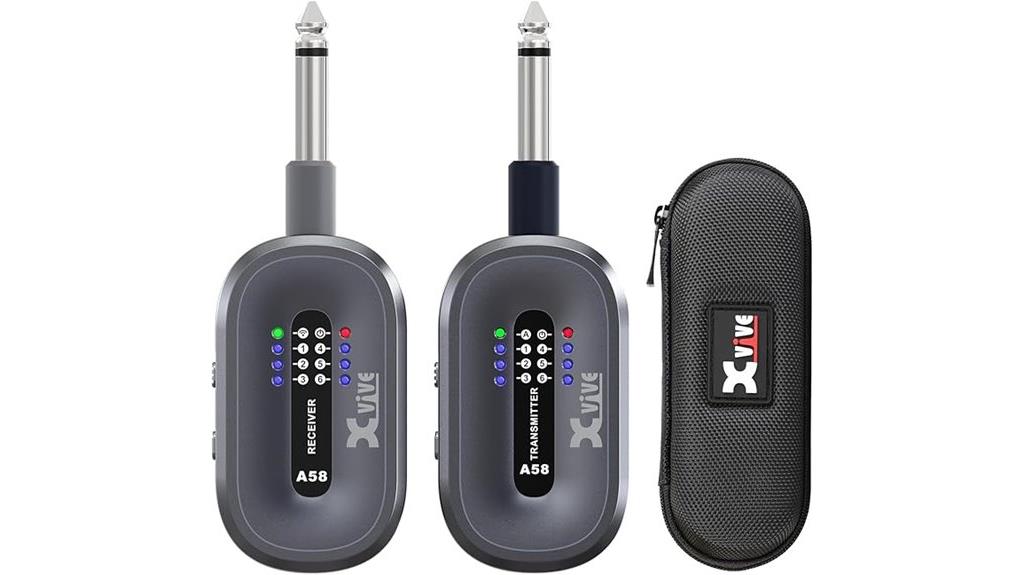
The Xvive A58 Wireless Guitar System stands out as an excellent choice for performers seeking reliable, high-quality wireless connectivity during live shows or studio sessions. Operating at 5.8GHz, it guarantees a stable, crystal-clear signal with less than 5ms latency, so you won’t miss a beat. With a range of over 100 feet and support for up to four systems simultaneously, it’s perfect for stage setups. The system includes rechargeable batteries providing up to 5 hours of continuous use, making it ideal for gigs. Its compact, lightweight design and compatibility with guitars and various devices make it a versatile and dependable wireless solution.
Best For: guitarists and performers seeking a reliable, high-quality wireless system for live performances, studio sessions, or presentations.
Pros:
- Operates on 5.8GHz band for a stable, interference-free connection
- Supports over 100 feet range with less than 5ms latency for seamless performances
- Compact and lightweight design with long-lasting rechargeable batteries
Cons:
- Price may be higher compared to wired alternatives
- Limited to 4 systems simultaneously, which might be restrictive for larger setups
- Requires charging, so batteries need to be managed for long gigs
Xvive A58 Wireless Guitar System (5.8GHz)

If you’re a musician tired of dealing with interference and signal dropouts during performances, the Xvive A58 Wireless Guitar System (5.8GHz) is an excellent choice. Its compact, lightweight design (just over 3 ounces) makes it easy to wear and move freely on stage. Operating on 5.8GHz, it provides stable, interference-free transmission with a range of up to 100 feet. The system offers high-resolution 24-bit/48kHz audio, no noticeable latency, and battery life over 5 hours. Quick charging and simple setup with auto channel selection make it highly reliable. Overall, it’s a practical, durable, and affordable option for musicians seeking seamless wireless performance.
Best For: musicians seeking a reliable, interference-free wireless guitar system with long battery life and easy setup for live performances or practice.
Pros:
- Provides stable, interference-free transmission at 5.8GHz with a range of up to 100 feet
- Delivers high-resolution 24-bit/48kHz audio with no noticeable latency or tone degradation
- Compact, lightweight design with quick charging and long-lasting battery life over 5 hours
Cons:
- May require manual channel matching when switching channels via scan mode
- Slight variation in aesthetic finish compared to previous models, which some users may notice
- Limited to specific device compatibility; not designed for non-guitar instruments
SWIFF Wireless Guitar System with Rechargeable Transmitter & Receiver

The SWIFF Wireless Guitar System with Rechargeable Transmitter & Receiver stands out as an ideal choice for musicians seeking reliable, high-quality wireless connectivity during live performances. Its advanced UHF transmission supports up to 100 channels, preventing interference even with multiple devices. The system’s 220° rotatable plug ensures effortless pairing, while its plug-and-play design makes setup quick and straightforward. Weighing just 0.21 kg, it’s lightweight and portable, perfect for gigs. With a long range of 164 feet and a delay of less than 2ms, it delivers clear, lag-free sound. The rechargeable battery provides around 5 hours of continuous use, making it both practical and dependable.
Best For: musicians and performers seeking reliable, high-quality wireless guitar and microphone transmission for live performances and practice sessions.
Pros:
- Supports up to 100 channels to prevent interference during multiple device use
- Long transmission range of up to 164 feet with minimal delay under 2ms
- Lightweight and portable at only 0.21 kg, with easy plug-and-play setup
Cons:
- Battery life of approximately 5 hours may require frequent recharging during extended gigs
- Limited to devices with a 6.35mm jack, which may require adapters for some instruments
- Microphone included may not suit all vocal or performance styles
LEKATO 5.8G Wireless Guitar System with Charging Box
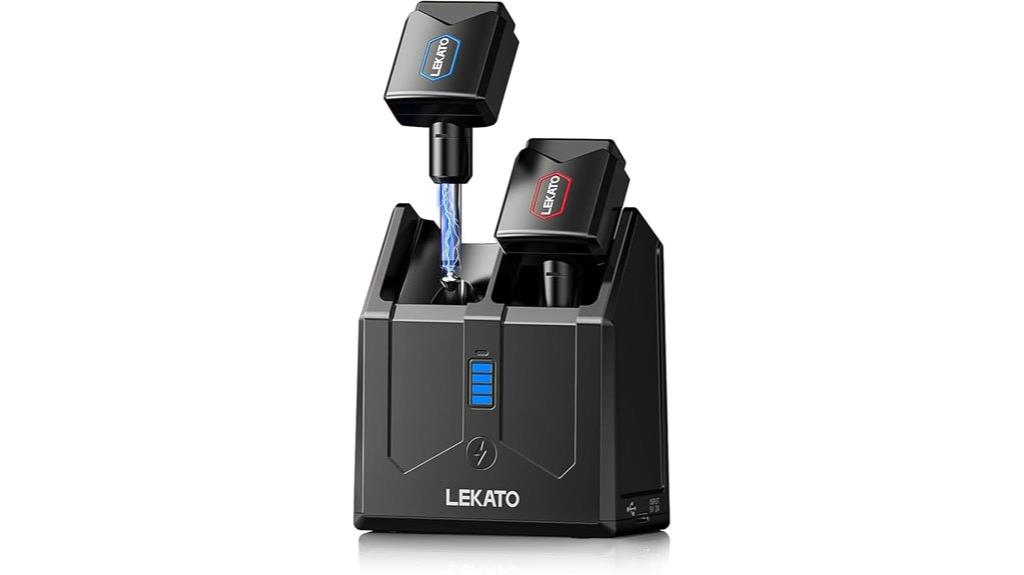
For musicians seeking a reliable wireless solution that combines high sound quality with portability, the LEKATO 5.8G Wireless Guitar System with Charging Box stands out. It delivers 24-bit 48KHz audio with minimal latency and supports four channels for multiple devices. Its compact design fits most guitars, basses, and keyboards, making setup quick and easy. The system’s auto-matching feature simplifies pairing, and the included charging box with a 5000mAh battery provides around 6–8 hours of use per charge. Plus, it charges both the transmitter and receiver simultaneously, offering a convenient, versatile option for practice, gigs, or recording sessions.
Best For: musicians seeking an affordable, portable, and easy-to-use wireless guitar system for practice, casual gigs, or recording sessions.
Pros:
- Simple setup with automatic pairing and rotating plugs for versatile connections
- Reliable wireless transmission with minimal latency and good sound quality
- Portable charging box with a built-in 5000mAh battery for extended use and convenience
Cons:
- Plastic build quality may feel cheap or flimsy for some users
- Uses micro-USB charging ports instead of USB-C, which is less modern
- Battery life may decrease over time, and occasional interference or signal dropouts can occur
LEKATO Wireless Guitar System with Charging Case

Designed for musicians who need reliable, long-lasting wireless connectivity, the LEKATO WS-100 system stands out with its rechargeable charging case that delivers over 12 hours of total playtime. It’s compatible with electric guitars, bass, keyboards, electric violins, and drums, with dual plugs—3.5mm and 6.35mm—eliminating the need for adapters. Operating on 2.4GHz, it boasts less than 6.7ms latency and a range of up to 100 feet, ensuring stable, high-fidelity signals. Its compact, lightweight design makes it perfect for gigs or practice. With quick one-hour charging and positive reviews, it’s a versatile, user-friendly solution for seamless performances.
Best For: musicians and performers seeking reliable, long-lasting wireless connectivity for electric guitars, bass, keyboards, violins, or drums in live, studio, or practice settings.
Pros:
- Over 12 hours of total playtime with a quick one-hour charge, ensuring extended performance sessions.
- Stable, high-fidelity wireless signal with less than 6.7ms latency and up to 100 feet range for seamless playing.
- Compatible with multiple instruments thanks to dual 3.5mm and 6.35mm plugs, eliminating the need for adapters.
Cons:
- Weighs approximately 9.2 ounces, which may be slightly bulky for some users during extended wear.
- Limited to 4 channels simultaneously, which might be restrictive for large band setups.
- Requires careful handling of the charging case and batteries to maintain optimal performance over time.
Upgrade 2.4GHz Wireless Guitar System with Rechargeable Battery
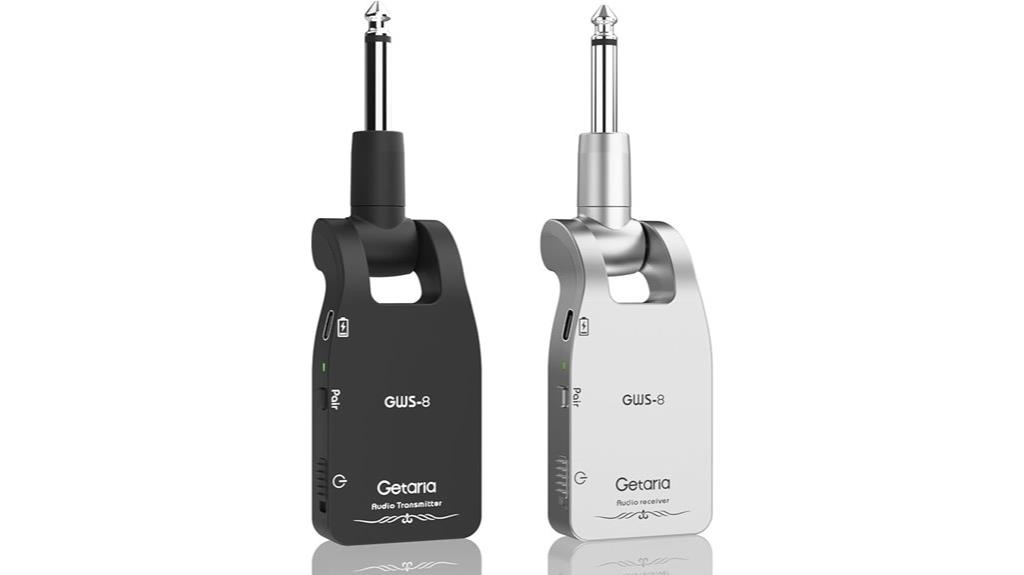
If you’re looking for a reliable wireless solution that keeps you connected during performances or practice, upgrading to the 2.4GHz Wireless Guitar System with a rechargeable battery is an excellent choice. It supports up to six devices simultaneously without interference, perfect for band setups or multiple instruments. The system offers professional sound quality with 24bit/48KHz stereo digital transmission, ensuring low latency and clear audio over 30 meters. Its stylish, adjustable design fits most guitars. The built-in 750mAh rechargeable battery and fast Type-C charging provide long hours of use with minimal downtime. Setup is simple, making it ideal for both beginners and pros.
Best For: musicians and band members seeking a reliable, interference-free wireless system for multiple instruments and performances.
Pros:
- Supports up to six devices simultaneously without signal interference.
- Offers professional-grade sound quality with low latency over a 30-meter range.
- Rechargeable battery and fast Type-C charging for extended use and minimal downtime.
Cons:
- Requires manual pairing for additional devices, which may be slightly cumbersome for some users.
- Compatibility may be limited to electric guitars, basses, and electric-acoustic guitars.
- The rotatable plug, while flexible, may add complexity for some players during setup.
Shure BLX14 Wireless Guitar System – H10 Band
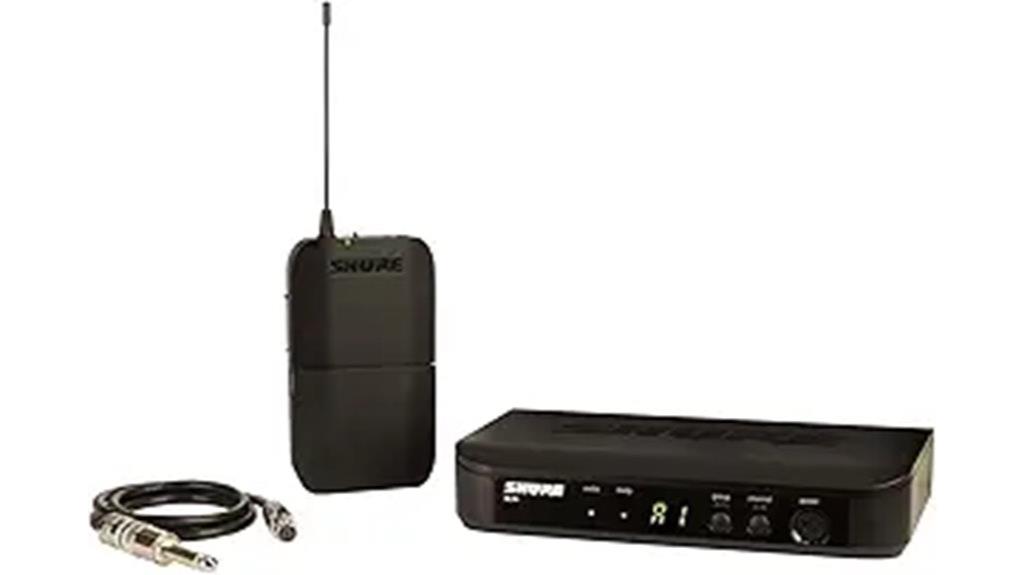
The Shure BLX14 Wireless Guitar System – H10 Band stands out as an excellent choice for musicians who need reliable, professional-quality wireless performance in small to medium venues. It offers seamless connectivity with no dropouts, thanks to its ability to scan for clear frequencies and maintain a stable signal even amidst Wi-Fi and other wireless devices. The system includes a durable receiver, bodypack transmitter, and versatile guitar cable, with intuitive controls and long battery life. Weighing just 2.7 pounds, it’s portable and easy to set up, making it perfect for gigs, church services, or stage performances where dependable wireless sound matters most.
Best For: musicians and performers in small to medium venues seeking reliable, high-quality wireless guitar or instrument performance with easy setup and long battery life.
Pros:
- Reliable connection with no dropouts or interference issues
- Easy to set up with quick frequency scanning and intuitive controls
- Long-lasting batteries suitable for extended performances
Cons:
- Limited to H10 frequency band, which may require checking local regulations
- Bodypack clip can be somewhat difficult to secure firmly
- Slightly heavier than some compact wireless systems at 2.7 pounds
Fender Telepath Wireless System, Mystic Ice Blue and Black

Looking for a wireless guitar system that delivers crystal-clear sound with minimal latency? The Fender Telepath Wireless System is a standout choice. Operating on a 5.8GHz digital signal, it avoids crowded bandwidths, offering a reliable 70-foot range and just 4ms of latency. It works with both active and passive instruments, featuring an articulating input plug that fits various jacks. The built-in cable tone simulation preserves your natural sound, while multi-unit pairing allows quick instrument swaps without unplugging. Available in Mystic Ice Blue and Black, it’s designed for seamless stage performance, earning high user ratings for clarity, ease of use, and versatility.
Best For: musicians seeking a reliable, high-quality wireless guitar system with minimal latency and versatile instrument compatibility for live performances and studio sessions.
Pros:
- Delivers full-frequency, crystal-clear sound with just 4ms latency
- Operates on 5.8GHz to minimize interference and congestion
- Supports multi-unit pairing for quick instrument switching without unplugging
Cons:
- First availability is July 1, 2024, so it may not be immediately accessible
- Slightly heavier at 8 ounces, which may affect portability for some users
- Limited to two color options (Mystic Ice Blue and Black), which might not suit all aesthetic preferences
5.8GHz Wireless Guitar Transmitter Receiver System

For musicians seeking reliable, low-latency wireless transmission, the 5.8GHz Wireless Guitar Transmitter Receiver System stands out as an ideal choice in 2025. This system, model JW-06, supports electric guitar, bass, keyboard, and more, with a compact design and rechargeable charging box offering up to 12 hours of use. It features four audio channels, allowing multiple devices to connect simultaneously, and easy pairing with a simple double-click. Its 5.8GHz frequency guarantees clearer audio, stronger anti-interference, and low noise, with a stable transmission range of 15-20 meters. Overall, it provides dependable, high-quality sound for live performances and practice sessions.
Best For: musicians and performers seeking a reliable, low-latency wireless system compatible with various instruments for live, practice, or recording sessions.
Pros:
- Supports multiple audio channels for versatile instrument pairing
- 5.8GHz frequency ensures clearer sound with minimal interference
- Long-lasting rechargeable battery providing up to 12 hours of continuous use
Cons:
- Jack cannot rotate, potentially limiting placement options
- Requires specific batteries, which may add to maintenance
- Slightly larger dimensions may impact ultra-compact setups
FW2D Wireless Guitar System with Mute Plug

If you’re seeking a wireless guitar system that guarantees noise-free operation and quick setup, the FW2D with its patented silent plug is an ideal choice. It uses 2.4GHz ISM digital transmission with FHSS, ensuring a stable, interference-resistant connection up to 98 feet. The system delivers high-fidelity sound with minimal latency (~5ms) and a broad frequency response. Its silent plug automatically cuts audio during plugging or unplugging, preventing pops or buzz. Compatible with all electronic instruments using 6.35mm jacks, FW2D supports multiple devices simultaneously and offers up to 10 hours of rechargeable use. It’s a reliable, hassle-free solution for live gigs and rehearsals.
Best For: musicians and performers seeking a reliable, noise-free wireless guitar system with quick setup and long battery life.
Pros:
- Stable 2.4GHz digital transmission with FHSS minimizes interference and ensures reliable connection up to 98 feet
- High-fidelity sound with minimal latency (~5ms) and broad frequency response (20Hz-20kHz)
- Patented silent plug automatically prevents pops and buzz during instrument plugging/unplugging
Cons:
- Complete elimination of interference cannot be guaranteed in extremely crowded environments
- Limited to devices with 6.35mm jacks, which may require adapters for some instruments
- Rechargeable battery life of up to 10 hours may require frequent charging for intensive use
Amazon Basics Wireless Guitar System Transmitter/Receiver
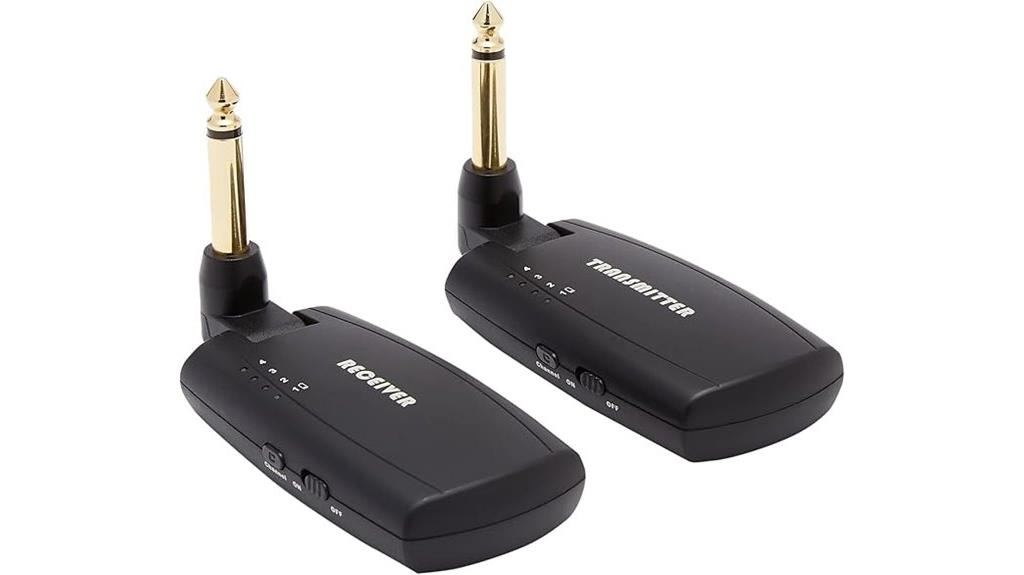
The Amazon Basics Wireless Guitar System Transmitter/Receiver stands out as an ideal choice for musicians seeking reliable, high-quality wireless connectivity without breaking the bank. It includes a transmitter and receiver with rechargeable batteries, designed for electric guitars, bass, keyboards, and other instruments with pickups. Operating on the 2.4GHz band, it delivers 24bit/44.1kHz hi-res sound with ultra-low latency under 5ms. With a range of up to 100 feet and a 220° rotatable plug for flexible connections, it’s perfect for live gigs, rehearsals, or studio work. Its durable build and user-friendly features make it a top budget-friendly option in 2025.
Best For: musicians and performers seeking a reliable, affordable wireless solution for electric guitars, bass, keyboards, and other pickups-enabled instruments.
Pros:
- Supports hi-res 24bit/44.1kHz sound quality with ultra-low latency (<5ms).
- Offers a generous 100-foot broadcast range with line-of-sight.
- Includes rechargeable batteries and features a flexible 220° rotatable plug for easy connection.
Cons:
- Limited to line-of-sight operation, which may affect range indoors or around obstacles.
- No mention of additional accessories or multiple channels for multi-instrument setups.
- Customer ratings, while good, suggest some users may experience occasional connectivity issues.
Aroma UHF Wireless System for Musical Instruments
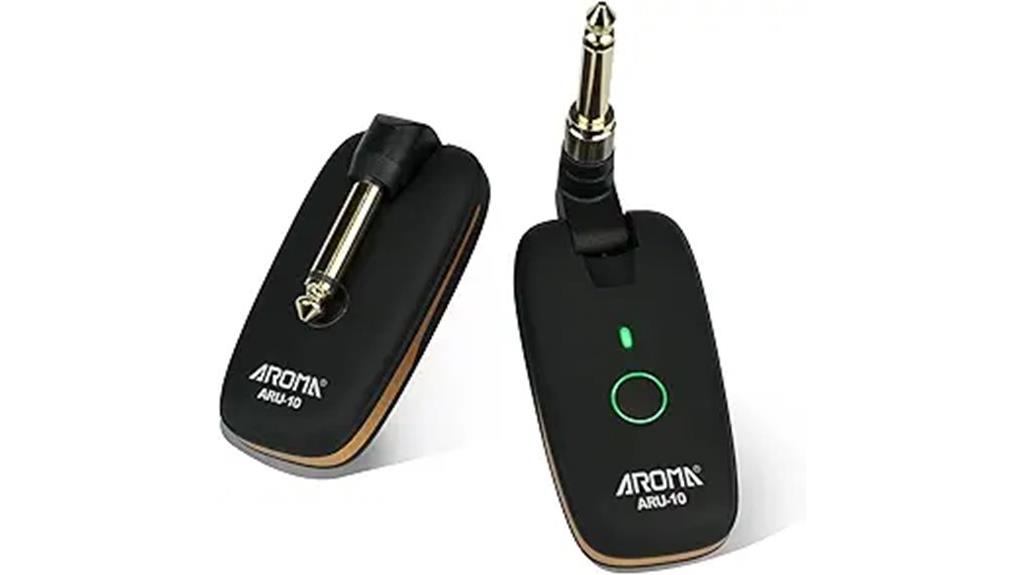
Musicians seeking reliable, professional-grade wireless audio will find the Aroma UHF Wireless System a perfect fit, thanks to its crystal-clear, lossless sound and minimal latency. It offers an effective range of up to 50 meters in open spaces, with strong anti-interference shielding for dependable performance. The system supports seven transmission channels, allowing multiple users or bands to operate simultaneously without interference. Its quick setup with one-touch power and instant pairing makes it user-friendly. Compatible with various instruments, it features dual jack options for easy integration. Built with a durable design and long-lasting battery life, it’s ideal for live gigs, rehearsals, and studio sessions.
Best For: musicians and bands seeking a reliable, high-quality wireless audio system for live performances, rehearsals, and studio recordings.
Pros:
- Offers professional-grade, lossless sound with minimal latency for clear audio transmission
- Supports up to 7 channels, enabling multiple users to operate simultaneously without interference
- Quick setup with one-touch power and instant pairing for user-friendly operation
Cons:
- Limited to USB A to USB C charging cables, as USB C to USB C is not supported
- Constructed from durable plastic, which may be less rugged than metal alternatives
- The effective range may be reduced in obstructed or indoor environments compared to open spaces
Factors to Consider When Choosing Wireless Guitar Systems

When choosing a wireless guitar system, I consider several key factors to guarantee it meets my needs. I look at the available frequency options, signal range, battery life, and compatibility with my instruments. Additionally, I pay attention to latency and audio quality to make sure my playing remains seamless and clear.
Wireless Frequency Options
Choosing the right wireless frequency for your guitar system depends on your specific environment and performance needs. The most common options are 2.4GHz and 5.8GHz bands, each with pros and cons. The 2.4GHz band offers broad device compatibility, making it a flexible choice. However, it’s more prone to interference from Wi-Fi, Bluetooth, and other wireless devices, which can cause dropouts. On the other hand, the 5.8GHz band tends to deliver a clearer, more stable signal with less interference, especially in crowded venues. Technologies like frequency hopping and digital transmission also help minimize interference, regardless of the band. For live performances in busy environments, 5.8GHz is often the better choice, providing a more reliable connection.
Signal Range Capabilities
The signal range of wireless guitar systems varies considerably based on technology and environment, typically spanning from 15 to over 100 feet. A longer range means greater stage mobility and freedom during performances, which is a big advantage. However, obstacles like walls, furniture, or equipment can reduce the effective range, so maintaining line-of-sight often guarantees the best performance. Different frequency bands, such as 2.4GHz and 5.8GHz, also impact the reliable signal range, with some bands being more susceptible to interference. Higher-quality systems tend to deliver consistent signal strength over their rated range, minimizing dropouts and degradation. When choosing a system, it’s vital to consider your stage size and environment to ensure your signal remains strong and stable throughout your performance.
Battery Life Duration
Ever wonder how long your wireless guitar system can keep up during a performance? Battery life duration is vital because it determines how long you can play without interruptions. Most systems offer between 4 to 8 hours of use on a full charge, with some high-capacity models exceeding 12 hours. Rechargeable batteries are convenient and cost-effective, but their lifespan can decline over time with repeated charging cycles. To avoid surprises, many systems include battery status indicators, so you can monitor remaining power and plan recharges accordingly. Fast-charging features are also helpful, allowing quick recharges during short breaks or between sets. Choosing a system with reliable battery life ensures your performance remains seamless without unexpected dropouts.
Compatibility With Instruments
When selecting a wireless guitar system, guaranteeing compatibility with your instrument is key to maintaining a reliable connection. First, check that the system’s input and output connectors match your instrument’s jacks, such as 1/4-inch or 3.5mm. It’s also important to verify support for both active and passive pickups if you switch between different guitars or instruments, ensuring seamless functionality. Additionally, look for systems with rotatable or adjustable plugs to fit various jack angles and prevent connection issues. Confirm the system’s compatibility with your instrument type—electric guitar, bass, acoustic-electrics, or electric violin—to avoid incompatibility. Finally, review the input impedance and signal levels supported to ensure your instrument’s output is handled without distortion or signal loss, delivering ideal performance.
Latency and Audio Quality
Choosing a wireless guitar system requires careful consideration of latency and audio quality because both directly impact your playing experience. Latency should be under 6 milliseconds to guarantee real-time response, so there’s no noticeable delay between your playing and what you hear. High audio quality systems typically support 24-bit/48kHz or higher, delivering clear, detailed sound essential for professional performance. Digital transmission technologies often provide lower latency and better fidelity by reducing signal processing delays. To maintain high sound quality, the system must minimize signal loss and interference, which can be achieved through effective frequency management and noise suppression. Ultimately, balancing low latency with superior audio clarity ensures your performance remains seamless, natural, and free of distractions.
Ease of Setup
Selecting a wireless guitar system that’s easy to set up can save you time and frustration, especially during live performances. I look for systems with auto-pairing features, which allow for quick, effortless connections without manual re-linking each time. Plug-and-play functionality is another big plus, letting me connect instantly and focus on playing. Devices with rotatable plugs or flexible connectors make installation on different instruments or jack angles much simpler. Clear indicator lights or status signals help verify successful pairing at a glance, reducing confusion. Additionally, systems with minimal buttons and intuitive controls are a real lifesaver—they make setup straightforward for both beginners and experienced players. Overall, these features help me get ready faster and avoid unnecessary hassle on stage.
Interference Resistance
To guarantee dependable performance on stage, it’s vital to evaluate how well a wireless guitar system resists interference. Systems operating on higher frequencies like 5.8GHz typically face less congestion than 2.4GHz models, reducing signal disruptions. Choosing a system with multiple channels—supporting four or more—enables automatic switching to the clearest frequency, especially in crowded environments. Anti-interference shielding and advanced frequency-hopping technology further enhance stability by avoiding interference from Wi-Fi or other wireless devices. Digital systems generally outperform analog ones, offering cleaner audio and fewer dropouts. Additionally, a good system should have an ample transmission range and the ability to detect and switch channels automatically, ensuring consistent performance regardless of stage or venue complexity.
Price and Brand Reliability
When evaluating wireless guitar systems, price and brand reputation play a significant role in guaranteeing dependable performance. Established brands with a proven track record tend to offer more reliable systems, reducing the risk of technical issues during gigs. Higher-priced models usually feature better build quality, stronger signal stability, and longer-lasting components, making the investment worthwhile. On the other hand, budget options might have fewer channels, limited range, or less durable materials, which can affect long-term reliability. Choosing reputable brands often means better customer support, warranty coverage, and firmware updates that extend the system’s lifespan. Comparing prices across trusted retailers helps guarantee you’re paying a fair market value and not overinvesting in unnecessary features or brand prestige.
Frequently Asked Questions
How Do Wireless Guitar Systems Affect Sound Quality During Performances?
Wireless guitar systems can impact sound quality, but when I choose a high-quality system, I notice minimal to no difference. They provide the freedom to move around without cable tangles, which enhances my performance. Modern systems use advanced digital technology to maintain clear, crisp sound with low latency. However, cheaper options might introduce noise or slight signal loss. Overall, investing in a reliable system guarantees my sound stays pure and consistent on stage.
What Is the Typical Battery Life for Various Wireless Guitar Systems?
Battery life varies vividly across wireless guitar systems, typically lasting between 4 to 10 hours. I’ve found that more robust brands often promise prolonged performances, providing peace of mind. Smaller, sleek systems might sip power quicker, while heavier-duty setups tend to sustain your sound longer. So, when I choose a system, I consider my gig’s duration and always carry a spare, ensuring my performance never pauses or pops.
Are Wireless Systems Compatible With All Guitar Types and Brands?
Wireless systems are generally compatible with most guitar types and brands, but it’s crucial to check specific models. I always verify if the transmitter fits my guitar’s output jack and if the system supports the necessary frequency range. Some systems might have limitations with certain active or multi-pickup guitars. To avoid issues, I recommend reviewing the manufacturer’s specifications and ensuring your guitar’s output and pickups are compatible with the wireless system you choose.
How Secure Are Wireless Guitar Signals Against Interference or Hacking?
Think of wireless signals like a secret handshake—when properly secured, they’re hard to intercept. I’ve found that modern systems use encryption and frequency hopping, making hacking or interference like trying to catch a whisper in a storm. While no system is 100% foolproof, I trust reputable brands that prioritize security. With these protections, your guitar’s signal stays safe, letting you perform confidently without worrying about disruptions.
What Are the Maintenance Requirements for Wireless Guitar System Components?
I make certain to keep my wireless guitar system components clean and dry, regularly check batteries, and update firmware when needed. I also inspect cables and connectors for wear and replace them if damaged. It’s important to store the system properly in a cool, dry place and avoid extreme temperatures. Doing these simple maintenance steps ensures my system stays reliable, performs well, and lasts longer.
Conclusion
Choosing the right wireless guitar system can truly elevate your performance. Did you know that over 65% of professional musicians now prefer wireless setups for their reliability and freedom? Whether you’re gigging on stage or practicing at home, investing in a quality system like those listed guarantees seamless sound and minimal interference. With so many options in 2025, you’re sure to find one that fits your style and needs perfectly.



